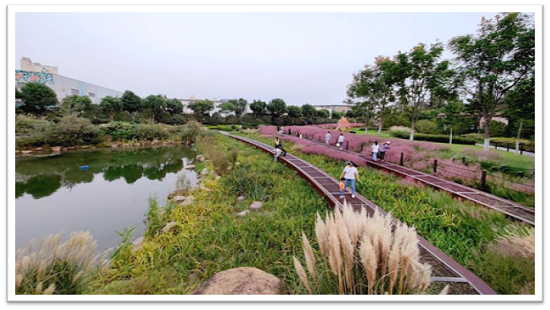
From Flooded Streets to Green Resilience: Mumbai’s Bold Plan for 164 Sponge Parks
In a city where monsoon deluges are both an annual ritual and a civic nightmare, the Brihanmumbai Municipal Corporation (BMC) is turning to nature for solutions. Under a forward-thinking plan that blends ecology with engineering, Mumbai will soon see the creation of 164 “sponge parks” across its landscape. Designed to absorb, store, and filter rainwater, these parks are a critical step toward tackling urban flooding, recharging groundwater, and building long-term climate resilience.
Around 164 sponge parks are being developed, with work already underway in select locations. The concept first emerged in 2021 under the Maharashtra government’s “Majhi Vasundhara” initiative, and has now gained significant momentum as part of Mumbai’s flood mitigation strategy.
Integrating Nature into Urban Infrastructure
According to Subhajit Mukherjee, founder of Mission Green Mumbai, the sponge park model merges environmental restoration with civic utility. “These parks use natural mechanisms like soil permeability and green cover to capture and absorb rainwater instead of letting it run off into overloaded drains,” he explained. “It’s a cost-effective and sustainable model that turns open spaces into functional climate assets.”
The idea is not just environmental idealism, it’s pragmatic urban planning. By reimagining existing gardens and open plots as part of a distributed water management network, BMC aims to build a city that can coexist with water rather than resist it.
A National-Level Flood Mitigation Effort
The sponge park initiative is part of a comprehensive proposal submitted to the National Disaster Management Authority (NDMA). This proposal outlines multiple flood mitigation measures, from infrastructure upgrades to ecosystem restoration. Additional Municipal Commissioner (Projects) Abhijit Bangar explained, “Plots will be identified and finalised soon. The interventions will not alter existing garden designs but enhance them—modifying soil, improving water percolation, and integrating natural drainage to prevent flooding.”
This integration of natural systems with engineered ones represents a shift from reactive flood control to proactive water management. The approach also supports the National Water Policy’s emphasis on sustainable urban hydrology and aligns with global best practices in climate adaptation.
Approvals, Funding, and Timeline
According to civic officials, the proposal is under review and expected to receive final approval and funding before the next monsoon season. The larger flood mitigation plan, estimated at ₹12,000 crore, includes 26 key measures for stormwater management, reservoir augmentation, and green infrastructure deployment.
Bangar noted that implementation will be phased, beginning with priority flood-prone zones. “The project blends structural and non-structural solutions. Once approved, work will progress in coordination with multiple departments, ensuring each intervention complements the broader flood resilience framework,” he said.
A Cost-Effective Model with Regional Momentum
Each sponge park is expected to cost around ₹10 lakh, making it an affordable yet impactful intervention. Beyond Mumbai, cities like Pune and Chennai have already adopted similar approaches. Mukherjee highlighted, “We successfully created one sponge park in Chennai and are collaborating with the Pune Municipal Corporation as well. These parks function as natural stormwater drains, absorbing excess water and reducing runoffs during intense rainfall.”
Pilot Project Near Mankhurd
Mumbai’s first pilot project is already underway near Lallubhai Compound in Mankhurd. A plot locally known as “Laal Maidan” is being developed to incorporate natural water absorption zones, with a smaller section functioning as a sponge park. The Mumbai Metropolitan Region Development Authority (MMRDA) has granted a No Objection Certificate, and a project management consultant has been appointed to oversee the execution.
Collaborative Effort Across Departments
The initiative is not confined to a single department. Deputy Municipal Commissioner of Gardens, Ajit Ambi, emphasized that while some sponge parks will be located within gardens, the stormwater drains department will lead the engineering component. “This is not just about beautification,” Ambi noted. “It’s about functionality—designing green spaces that double as natural flood prevention systems.”
What Makes a Sponge Park Work
Sponge parks are inspired by the concept of “sponge cities,” pioneered in China and increasingly adopted worldwide. They combine permeable surfaces, vegetation, and natural contours to retain and gradually release stormwater. The system reduces runoff pressure on drains, minimizes flooding, and promotes groundwater recharge.
In Mumbai’s case, these parks will act as micro-level buffers against extreme rainfall events, allowing the city’s vast stormwater network to function more efficiently. The long-term benefits include reduced flood intensity, improved soil health, and a measurable rise in local groundwater tables.
Rising Rainfall, Rising Urgency
According to BMC data, the city has experienced a sharp increase in extreme rainfall events. Over the past six years, the average “very heavy rainfall” within a 24-hour period has climbed from 132 mm to 182 mm. This intensification has triggered flash floods that disrupt transportation, damage infrastructure, and threaten lives. With climate change amplifying the risk, the urgency for adaptive solutions like sponge parks has never been greater.
Charting the Future of Urban Resilience
Mumbai’s sponge park project represents a fundamental shift in how cities can integrate natural resilience into urban design. By treating open spaces as living infrastructure, the city is redefining the purpose of public land—from decorative to functional, from reactive to regenerative.
If implemented effectively, the initiative could become a model for other coastal cities facing similar climate threats. The success of this effort will depend not only on engineering precision but also on civic participation and maintenance. After all, sustainability is not a one-time investment—it’s an evolving partnership between nature and governance.




